It goes without saying that you’ll find history everywhere you look in downtown Lisbon. It’s an ancient city, after all: about four centuries older than Rome. If you’re like me, and you love history, then downtown Lisbon is an absolute treasure trove. So let’s start at one of the places in the city where that ‘feeling’ I just described is so strong.
Praça do Comércio
Imagine yourself in a massive square in downtown Lisbon. It’s largely empty, except for a statue of a former Portuguese king right in the center. Each side of the square is lined with beautiful yellow buildings. In front of you, the River Tagus, the Tejo… which empties itself into the vast Atlantic, which lies just around the bend.
You’re standing in the square we call today the Praça do Comércio. Now, at first glance, the Praça do Comércio feels elegant… and also, kind of uneventful. But that couldn’t be further from the truth. In fact, you’re standing on one of the most consequential spots in all of Lisbon: the city’s history changed significantly here… not once, but twice!
The first was over 100 years ago. In 1908, this square held the Royal Palace – which had been home to the Portuguese royal family for 150 years. And Portugal had been ruled by its monarchy since 1139. But on February 1st, 1908 – all that changed. The Portuguese king, King Carlos I, and his son, Prince Luis Filipe, were fatally shot here. Their assassinations would mark the beginning of the end of the country’s nearly 800-year-old monarchy… By 1910, it was abolished. And it all started right here in this square.
Believe it or not, that’s not even the craziest thing that happened in this square. That award goes to the morning of November 1st, 1755. Back then, the Royal Palace hadn’t been built in the square yet. For two and a half centuries, this square had been the epicenter for the bustling trade and maritime exploration that has defined Portugal. Public celebrations, fairs, and markets all took place here. At one point, a rhino and an elephant are actually walked around in this square(!)… just two of the wild animals that were brought back during the Age of Discovery as gifts to the king.
But on the morning of All Saints’ Day, the residents of Lisbon feel the ground begin to shake. The shaking continues for upwards of 3.5 to 6 whole minutes. Fissures measuring up to 4.8 meters (16 feet) open up throughout the city. Buildings collapse. Frightened survivors stream to this square and Lisbon’s riverfront for safety – away from the buildings and the destruction. This turns out to be a grave mistake.
Forty minutes after the initial earthquake, stunned Lisboetas watch as the river Tagus recedes into the Atlantic. They’re mesmerized as shipwrecks that litter the riverbed are revealed, one by one. But they’re soon shaken from their stupor at the sight now rushing towards them. A wall of water – the Atlantic – rushing back up the River Tagus, right for Lisbon.
An enormous tsunami swallows the entire square and a good portion of downtown Lisbon. Buildings that date all the way to the Roman occupation are destroyed. In the churches that still stand throughout the city, candles that had been lit for All Saints’ Day topple over, setting fires that soon merge and turn into a raging firestorm, destroying most of what is left of Lisbon.
This earthquake, tsunami, and fire would lead to changes that would define Portugal and Lisbon forever: it’s estimated that upwards of 20% of Lisbon’s population were killed. The city itself would have to be almost completely rebuilt. The modern field of seismology itself was born out of this disaster.
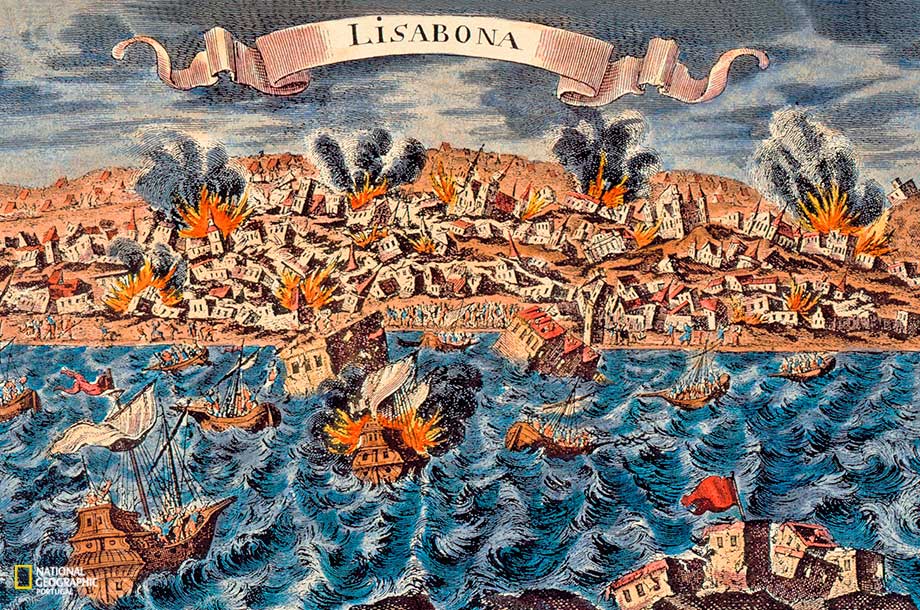
Georg Caspar Prauntz’s depiction of the 1755 earthquake, c/o National Geographic
And to this day, a great deal of downtown Lisbon still bears the scars and the record of this event. On its streets, you’ll see structures that vary in age by a millennia or more. Roman ruins from 300AD next to modern structures from the 1800s. And 19th century buildings whose basements hold the ruins of structures from the 1500s. And it all comes down to what that natural disaster destroyed and what it spared.
Lisbon is a city that has bounced back more than once. We’re a city of survivors; of people who love life. And you’re the lucky traveler that gets to experience Lisbon during what can only be described as another one of our Renaissances. There’s never been a better time to explore it. World class food, art, entertainment, culture… and still, its ancient and proud history – are on display everywhere.
Let’s start right back in the Praça do Comércio, the large yellow square that changed history. There, you’ll find the Lisboa Story Centre, where you can learn all about Lisbon’s long history. If you have time, go up to the arch of the Rua Augusta, which overlooks the Praça do Comércio square. From the top of the arch, you get a really unique, bird’s eye view of Lisbon.
Miradouros
Seeing the city from great heights brings me to one of my favorite things about Lisbon: the belvederes, or viewpoints, which we call miradouros. Scattered throughout the city, each miradouro has its own unique perspective – and they’re free to visit. My favorite is the Miradouro de São Pedro de Alcântara. It’s extremely popular and with good reason. From there, you can see the river, the castle, and all the way uptown. The miradouro has a fountain and some beautiful Portuguese calçada stonework. There’s also a quiosque, where you can sit down for a drink and take in the memorable sights. Another popular miradouro is the Miradouro de Santa Luzia. And this one is an Instagrammer’s mecca. It has beautiful azulejo tilework, stone columns, flowers, and views of the old part of town and the river. Predictably, it gets really crowded.
That’s why I recommend going to some of the less visited belvederes, like the Miradouro das Portas do Sol (which has essentially the same views as the Miradouro de Santa Luzia but is slightly less crowded). Even though it’s an uphill walk, the Miradouro da Senhora do Monte has terrific views going from the river all the way uptown that make the cardio worth it. My advice is to visit a few miradouros and find one that speaks to you.
One of my favorite spots is the Jardim do Torel. It has a garden where you can sit down and relax and enjoy the views, and a small pool to dip your feet on a hot day. And the last time I was there, I saw people dancing on a rooftop nearby.

The Castle
If, like me, you can’t get enough of seeing Lisbon from the top down, then head over to the Castelo de São Jorge – one of Lisbon’s most iconic buildings. The origins of the fortification date all the way back to the 7th century! And because it was built to defend the city against invaders, you can expect the views to be pretty spectacular.
There’s more to the castle than its long history: it’s an experience. So, at the start or end of your visit to the castle, sit down with an ice cream or a glass of wine in the seats inside the castle walls and take in the sun, the views, and the peacocks who live in and stroll around the castle. As tempting as it is to make friends with them, please don’t feed or touch them.
After visiting the inside of the castle, walk around the walls to look out over different parts of the city. If you can, visit the often-overlooked archeological site on the opposite end to the entrance. That site – the Praça Nova – will literally show you the evolution of the castle and Lisbon itself – it has Iron Age settlements, Moorish houses, and the remnants of a 15th-century palace once inhabited by the Bishop of Lisbon.
Alfama
When you’re done at the Castle, you can go one of two ways: you can head to Alfama, the oldest part of the city, or towards the Baixa. Alfama is believed to be the second-oldest neighborhood or quarter in all of Europe. And the oldest house in Lisbon, which is 500 years old and survived the earthquake of 1755, can be found here in the Rua dos Cegos.
Alfama is synonymous with fado: a traditional, often sad, style of music unique to Portugal. If you really want an immersive experience in Lisbon, find a restaurant that plays live fado music in the evening. Clube de Fado, near the Sé de Lisboa, and A Parreirinha de Alfama are great options. Aside from traditional fado music, those restaurants also serve traditional Portuguese food. And although Lisbon is a largely safe city, just beware of pickpockets in Alfama, or any other crowded, touristy area for that matter.
Downtown Lisbon
Contrary to the winding, medieval streets of Alfama, the streets of the Baixa area are grid-like. That’s because this part of the city was rebuilt after the earthquake of 1755. The streets of Rua Augusta, Rua do Ouro and Rua da Prata are historically where you came to buy jewelry. These streets will take you from the Praça do Comércio to Praça D. Pedro IV (but we locals refer to it as the Rossio) and Praça da Figueira.
Normally, I don’t recommend eating at the restaurants in the Baixa area because of the number of restaurants there that are largely catered to tourists and not the finest examples of our food. Of course, there are exceptions, you just have to know them. For example, if you like a quirky spin on your food and eclectic décor, head over to Bastardo. Another recommendation is Martinho da Arcada, on the corner of the Praça do Comércio and Rua da Prata. This restaurant and café was founded in 1778, and it’s the oldest restaurant in all of Portugal!
Another place I love is the Confeitaria Nacional: this bakery and coffee shop is nearly 200 years old and used to be the official supplier to the Portuguese royal family. And since 1940 it has supplied food to the Presidency. If you get the chance, pop inside, admire the beautiful interior and treat yourself. Manuel Tavares, Lda., just a few doors down, is a great place to stock up on quality Portuguese foods and drinks. This store, founded in 1860, is perfect for picking up some souvenirs to take home with you, or for grabbing a few snacks.
Rossio & Avenida da Liberdade
Next, head over to Rossio, a large square with a fountain and a statue. It’s the location of the first calçada portuguesa: the beautiful black and white mosaic stones on our sidewalks. Cross the square and you’ll see a large theater in front of you – that’s the Dona Maria II National Theater, which has some of the best classical music and theater in the city. And, on your left, you’ll see a stunning 19th century train station (take pictures, it’s such a special building) – that’s the Estação do Rossio.

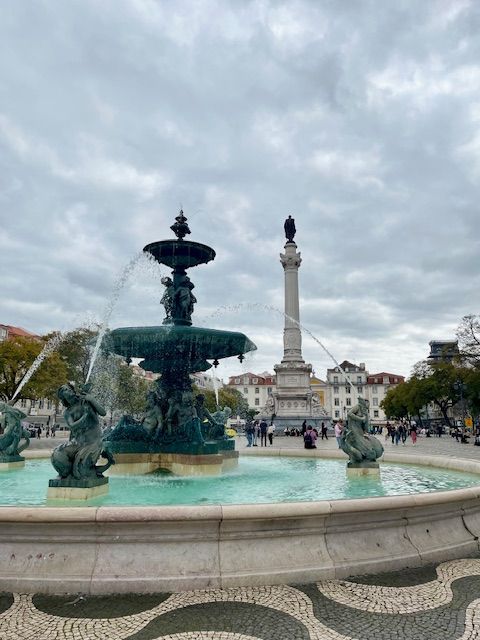
Keep walking away from the river and you’ll find yourself at the bottom of the Avenida da Liberdade. I love walking up and down this avenue, which is a cross between the Champs-Elysées in Paris and the streets of Buenos Aires. This is where you go to do some luxury shopping in Portugal. Personally, I love the Avenida da Liberdade for its gorgeous buildings and quintessential Portuguese features: for example, the calçada portuguesa designs here are so ornate and beautiful. There are also several quiosques where you can stop to have a drink or a snack. The trees along the avenue provide avid walkers like me with much-needed shade during the hot summers. And the classic buildings that line the avenue are nothing short of stunning. On Sundays in the summertime, there’s even latin dancing in Avenida da Liberdade, which is an incredible ambiance.
Secret Spots
The Avenida da Liberdade and the Baixa are obvious places to visit. But it’s easy to miss out on some of the sights that are a little off the beaten track. So now I’m going to tell you about some of my most treasured, more hidden, spots in downtown Lisbon.
The Igreja de São Domingos is a personal favorite of mine. Built in 1241, important historical events took place in that church and the square in front it. This church witnessed royal weddings, Inquisition trials, conspiracies during Portugal’s 1640 Restauration War, and countless fairs and markets over the centuries. And it’s been ravaged by earthquakes and fires on several occasions. It’s almost symbolic of Lisbon: like the city, it has survived so much, but it’s still standing. In 1959, yet another fire broke out and the inside was completely destroyed. It only reopened again in 1994. Today, you can go into the church and see its burnt interior, which is a really unique experience and something most visitors miss. But please be respectful when you visit, because it is a place of worship.
Another off-the-beaten-track spot is the more relaxed and bohemian Miradouro de Santa Catarina. There, you’ll find a statue of the Adamastor, a mythological creature from the most famous book in Portuguese literature, Os Lusíadas. The Adamastor figure represents what was once called the Cabo das Tormentas, or the Cape of Storms, so he’s not the handsomest of sculptures… but today the Cape of Storms, which sits at the bottom of Africa, has a different name.
The story goes: the Portuguese explorer Bartholomew Dias first made it to the cape in 1488. The explorers faced terrible storms, so he named it the Cape of Storms. But when word reached our King John II that the Portuguese had reached the place where the Atlantic and Indian Oceans meet, it gave him hope that the Portuguese were close to discovering the maritime route to India. So, he rebranded it (so to speak) as the Cape of Good Hope, in present-day South Africa. The Miradouro de Santa Catarina won’t let you see as far as India, but it does have views of the Tagus river, the bridge, and the statue of Christ the King the statue of Christ the Redeemer on the other side. And, of course, there’s a kiosk there…
If those views make you hungry, head over to Pharmacia, right in front of the miradouro. This restaurant used to be an old pharmacy and still features the original cabinetry. It’s decorated with old-fashioned medicines and medical supplies, and even the items on the menu have medical names.
Another somewhat hidden spot I love, but in the Chiado area, is the Topo Chiado. This rooftop bar behind the Convento do Carmo has spectacular views overlooking some of Lisbon’s most iconic attractions. It also has beers on tap, cocktails, and light bites. Because it’s kind of hidden behind the convent, it’s a little less crowded than some other places in the area.
Speaking of drinks with a view, I highly recommend finding a rooftop bar or restaurant at least once during your stay. Lumi, Javá, Rossio Gastrobar, Topo Martim Moniz, and Memmo Alfama Terrace are just a few that I like. For views both during the day and night, arrive during the late afternoon to soak in the sights, watch the sun setting over the river, and then see the city come alive again at night.
Another place where you can see Lisbon from the top down is the Elevador de Santa Justa, or the Santa Justa Lift. It was built by a prominent Portuguese architect who studied in France with Mr. Eiffel (of tower fame). After visiting the Santa Justa Lift, walk up the Rua do Carmo and turn right onto the famous Rua Garrett. Here, you’ll find some beautiful historical shops like the Pequeno Jardim florist and the Paris em Lisboa department store, built in 1888. These are remnants of Belle Epoque Lisbon, and they really add to the city’s old world charm.
Further up, you’ll see the famous Art Nouveau café, A Brasileira, built in 1905. It’s practically mandatory to take a photo with the statue of renowned poet, Fernando Pessoa, who often visited here. The statue is on the esplanada, the outdoor seating area, of the café. Remember the oldest restaurant in Portugal that I mentioned earlier (Martinho da Arcada)? Fernando Pessoa was a frequent patron there as well, and his usual table there is marked. Fernando Pessoa’s kind of a big deal here in Portugal.
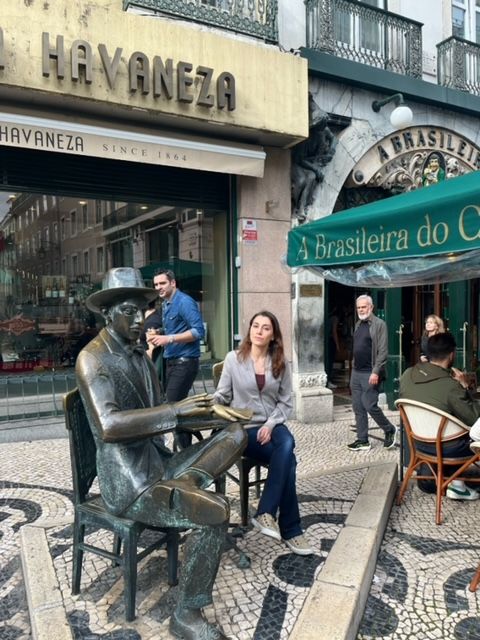
From Rua Garrett, head up to the Carmo Convent that was destroyed in 1755 by the earthquake and resulting fire. For various reasons, it was never fully rebuilt. Today, you can visit it and see the remaining pillars and arches of this late 14th century building as they frame the sky. It’s a meaningful experience for a lot of people – a manmade cathedral framing the cathedral of nature. You can buy your tickets at the entrance of the Convent.
Next, head over to the Largo de Camões, the square named after Portugal’s Shakespeare, Luís de Camões – the writer and poet who wrote our most famous piece of literature, the one with the mythological creature I mentioned above.
If you’re looking at the statue of Camões, you can go several ways: if you go downhill towards the river, you’ll end up at Pink Street. This street used to be a red light area with a not great reputation, but it’s now an Instagrammer’s dream with its pink-painted asphalt and rainbow colored umbrellas covering the street. Be mindful of pickpockets here as well. From there, you can also walk to the very popular, but extremely busy Time Out Market where you can choose from dozens of restaurants to eat. It’s a good place to sample different foods if you’re unsure of what you want. But if you’ve done your research and know what restaurants you’re looking for, go straight to the original restaurant instead of the Time Out market branch of that restaurant. It’s just so crowded a lot of the time, and you’re not guaranteed a seat once you’ve got your food.
Back at the Largo de Camões, if you head uphill instead of down, you’ll have the neighborhood called Bairro Alto to your left and, a little further, the Miradouro de São Pedro de Alcântara, that I mentioned earlier. Bairro Alto is known for its nightlife with dozens of bars and restaurants. Again, it’s not dangerous, but be careful with valuables in easily-accessible pockets. Also, even though Bairro Alto seems like one big street party, remember that people do live there and they can hear you in the streets.
If you keep going up the Rua da Misericórdia past the belvedere on your right, you’ll end up in Príncipe Real. This trendy and affluent part of Lisbon has nice restaurants and shops, and even a botanical garden. Pop into EmbaiXada, which is a former 19th century palace turned into a small mall, to pick up some souvenirs. But my favorite part of Príncipe Real is the square, which has two kiosks to choose from. Plus, there’s a farmer’s market there every Saturday morning, as well as an antiques market twice a month.
Before I finish, I want to leave you with a couple more tips for Lisbon. My first tip is about the number 28 tram, which has a particularly scenic route. For about 3 Euros, you can ride this tram and see some of Lisbon’s most iconic locations, giving your feet a little break from all the walking.
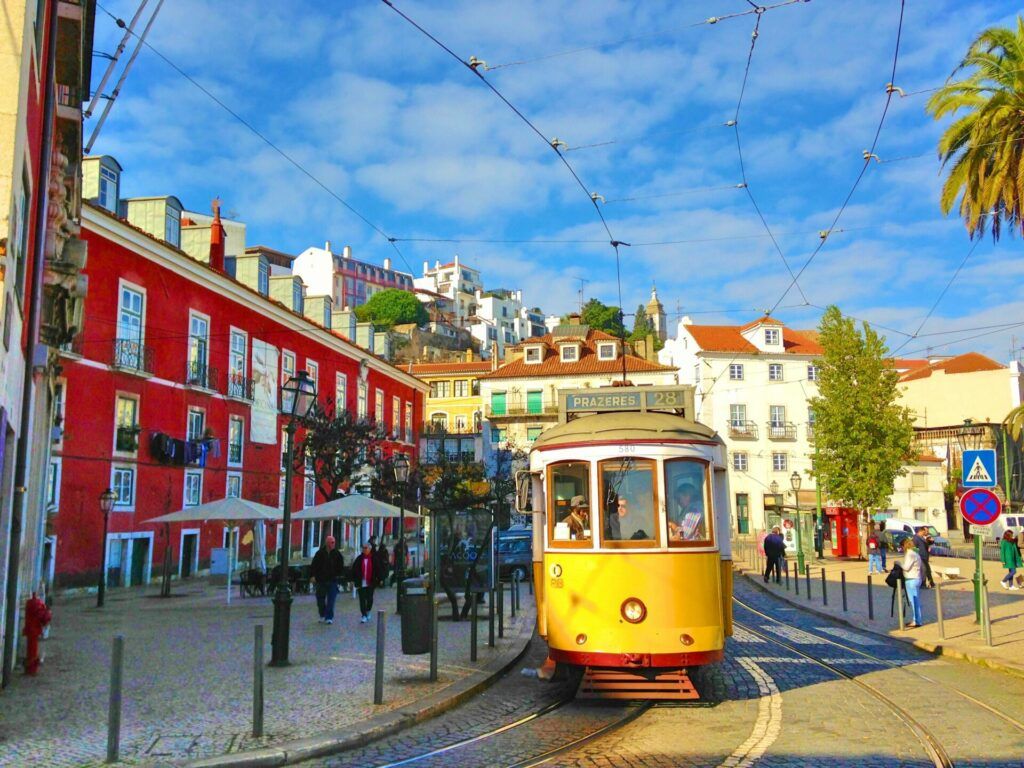
My second tip is for anyone planning to do a lot of sightseeing and using public transportation to get around: consider getting a Lisboa Card for your stay. You can buy one online, and, with it, you get unlimited travel on public transportation and either free entrance or discounted rates into lots of attractions.
I’ll be posting a second part to Visiting Lisbon soon, so stay tuned for more tips to get the most from your time in Lisbon.
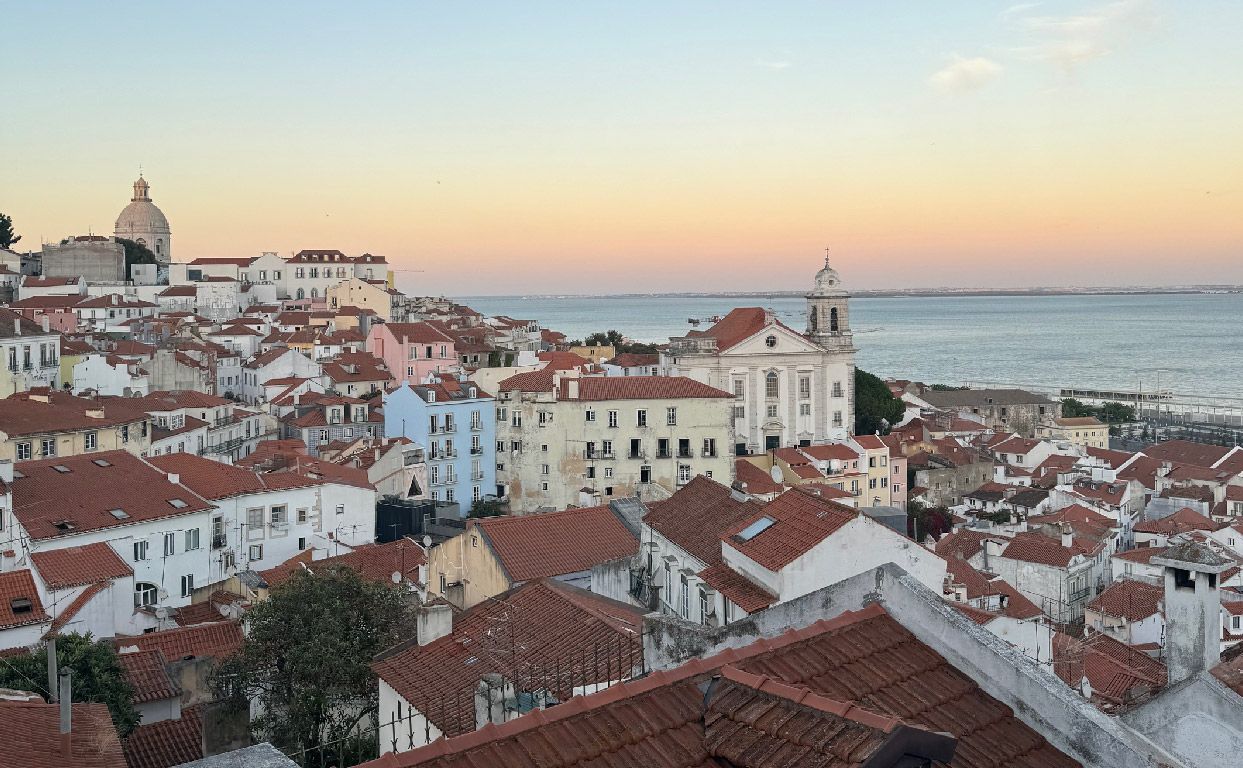


what a lovely article about a lovely city. inspires me to go back asap and do some miradoura hopping
thanks
Thank you for the kind words, Andy!